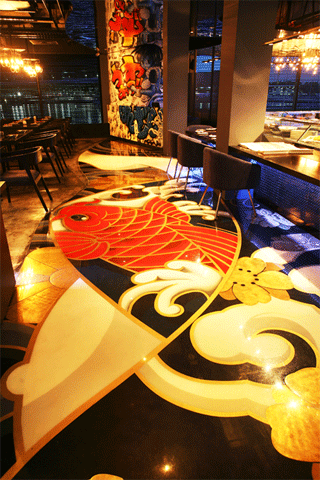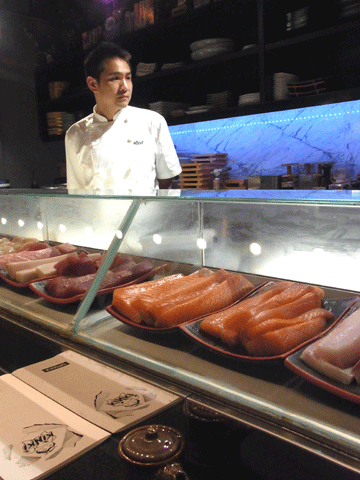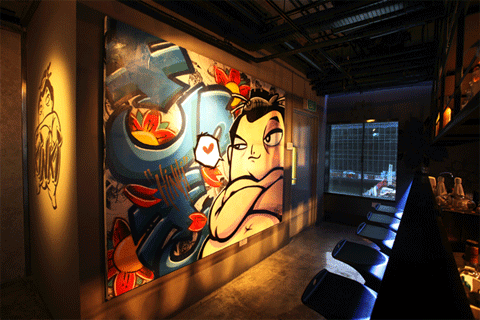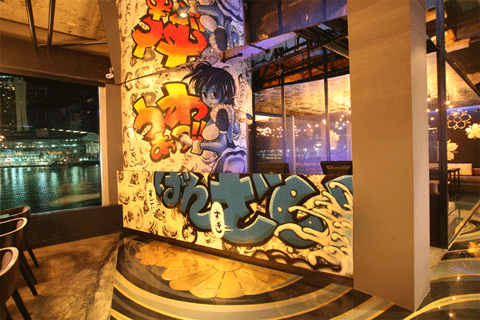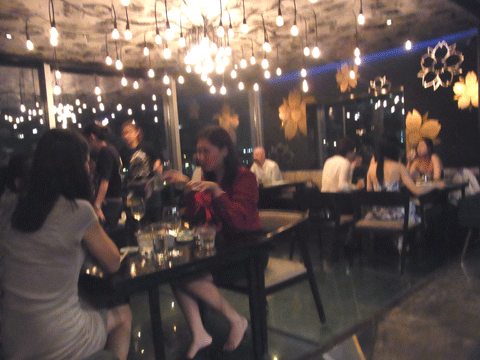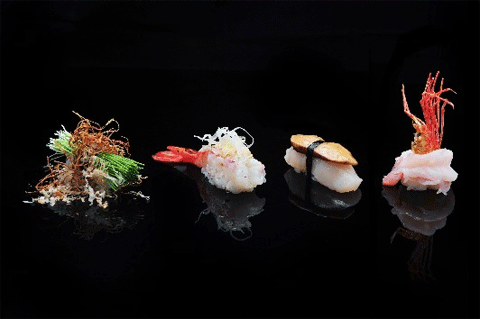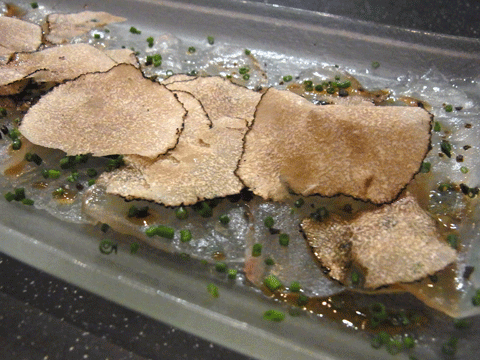Three Singapore-based F&B companies joined hands and created The Big Idea. The five owners are childhood friends. In their childhood, they vowed to do something together when they grow up. Finally in 2012, that became reality. Their family businesses are transforming into a major food business. The keyword here is "modesty".
" Kinki Restaurant + Bar" Japanese restaurant.On the floor of the facade is a huge carp tattoo.
The Big Idea consists of three restaurant management groups. The base company is Refinery Concepts, which owns restaurants such as Japanese restaurant "Kinki Restaurant + Bar" and Japanese-style steak house "Fat Cow".
In June this year, Marmalade Group came into the picture. The company owns Bistro "Marmalade Pantry" located in two locations such as shopping mall ION, and its fast-food version "Marmalade Toast".
Followed by the merger of The Food Chain in August this year as well. The company owns steak house "Bedrock Bar & Grill" and Coffee shop "Oriole Café & Bar" located at three locations.
The Big Idea, combing the three groups now own 12 restaurants. Mr. Keith Loh, the founder of The Food Chain, became the CEO of the company. Other board members are the members of the merged Marmalade Group and Refinery Group. There are five owners but Mr. Loh is the only full-time member.
"The owners of the merged companies are actually my childhood friends or close friends. Five of us agreed to do something together 12 years ago. We can achieve more when all five of us come together. I work full-time, but the others help me part-time", said Mr. Loh.
"Up to four restaurants one person can be in charge, but when there are six there is a need for a corporate culture. The staff will not follow the person but rather the company. 90 percent of restaurants will fail in the end. It is because they do not consider it as a business. Passion only is not enough. An idea will not last for 10 years. Three years down the road, you will need a new hat."
"The product is important but human resource is the most important factor. If you are humble and not arrogant, people will want to follow you. You need to understand compassion and team work. You need to continuously zoom out to see the whole picture of the company and zoom in to see the staff. You have to see what is happening around the world and bring it back to the company. I do not make decisions on my own. Because I am a team player now."
Amongst the 12 restaurants, Japanese restaurant "Kinki" is generating the best result. It opened at the end of 2011 and is located on the second floor of the former custom house facing the Marina Bay, which is now transformed into a commercial facility. It is located in a strategic location where you can see Marina Bay Sands across the reservoir and there is a roof-top bar on the third floor. They are planning to open an outlet in Bangkok within this year as well.
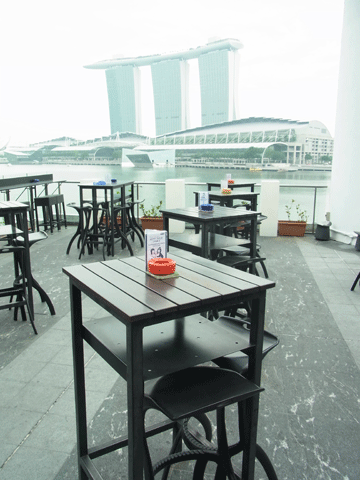
" Kinki Restaurant + Bar" Japanese restaurant. Opposite the Marina Bay Sands.
Sushi Counter
The interior is designed not so much like a traditional Japanese restaurant, but with a modern touch. A Japanese tattoo art painted on the floor of the entrance welcomes you in. Guests are surprised to see this when they alight the elevator. The artwork is done by a tattoo artist from Miami, Chris Garver. The restaurant is mainly table-seating, while there is a Sushi counter and a bar counter for some who prefer quick bites.
The main character of the restaurant is a Sumo wrestler. The name "Kinki" comes from a type of fish, as well as other meanings such as 'sexy', 'fun' and 'playful'.
Sumo wrestler character.
Japanese animation is paint everywhere.
Animation is also on the menu.
"In a western concept, bars are very important. It generates an atmosphere where you can have a drink. People will not only come to eat, but to enjoy themselves. I know how to manage a bar because we have been running many western restaurants. So, we transformed a traditional Japanese concept into a western one. A western touch is infused in the layout, design and atmosphere with the traditional high quality Japanese cuisine. It's urban, city-like, modern, fun and a little bit sexy."
Crowded with local OL.
"Bars usually close down within three years. This is due to the lack of attractiveness. When you combine both restaurant and bar, you get a perfect concept. The restaurant helps the business of the bar, and the bar helps the business of the restaurant. The most successful restaurant concept is a modern concept, and we paired it up with a bar."
"Customers do not separate the bar and the restaurant. You might be the host of the night and invite people, or celebrate a special night, or one member might come in late due to traffic jam. You can use this place for various purposes."
"It is $30-40 per person for lunch and $80 in average for dinner, which is a reasonable price. Alcohol sales account for 30-40 percent of the sales generated by the restaurant itself without including the sales from the roof-top bar. Even without pushing alcohol to customers, as long as you take good care of your customers, it will sell by itself. That is our mission. Be fully committed as being the host, provide an unforgettable experience and bring people together. When you are able to bring people close together like a family, everyone is happy."
Sushi is unique. Material is fresh.
Carrying the truffle carpaccio.
"Most business is done at a table. Not in the office. This is a good place to close the deal or even when starting one.Location is one of the most important elements. No matter what kind of business you are doing."
"Our landlord also trusts us because of our track record over the past 10 years. Good relationship, good brand, good integrity, good reputation, good culture and concept. With this, landlords are willing to work with us too."
Mr. Loh majored in Finance in University and takes on the role as the finance manager for his family business as well. He is also the founder of the on-going free-paper "JUICE" that covers topics of local fashion, music and culture. He has sold the business already. His hobby is monochrome pictures. His very first F&B business was a seafood restaurant which after changing its business concept became the present "Fat Cow".
"I want to constantly create something for people. I do not want to do business of just buying and selling. Fortunately, restaurant business suits me very well. It makes my dreams come true. I am happy when I am with people."
"The chef decides the menu and listens to the customers' voice. 40-50 percent of the menu will be changed after a year. It constantly changes. 1 percent of it changes every week. Small changes are continuous made and in about 100 weeks the whole thing is completely different. Competition is a good thing. It makes you humble and realistic. When a competitor emerges, you start to think how to differentiate yourself. The key is the people. Maybe there will be changes in the concept as we go along, but the most important thing is that your people follow you."
He respects his staff and puts emphasis on staff development. There is hardly any staff that leaves the job. "Humble" is the word Mr. Loh mentions often when he speaks. When he is at "Kinki", you can see that he is friendly with his staff and they seem confident in their job. I also felt hospitality in their service. This must be the picture of a restaurant business that constantly changes itself and survives in the long run.
